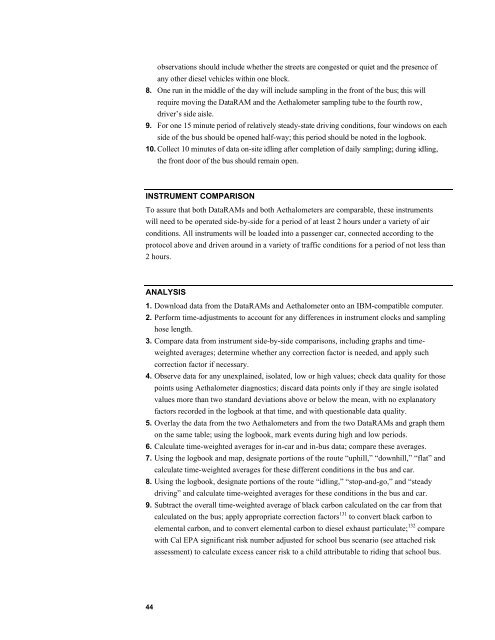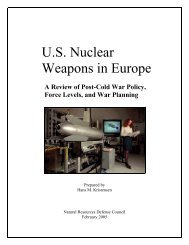NRDC: No Breathing in the Aisles: Diesel Exhaust Inside School ...
NRDC: No Breathing in the Aisles: Diesel Exhaust Inside School ...
NRDC: No Breathing in the Aisles: Diesel Exhaust Inside School ...
You also want an ePaper? Increase the reach of your titles
YUMPU automatically turns print PDFs into web optimized ePapers that Google loves.
o bs er vatio ns sh ou ld <strong>in</strong> clu de w he<strong>the</strong>r <strong>the</strong> s tr eets are con g es ted o r qu iet an d th e p resen ce o f<br />
any o th er diesel veh icles w ith<strong>in</strong> o ne block.<br />
8. O ne r un <strong>in</strong> th e midd le of th e day w ill <strong>in</strong>clu d e sam pl<strong>in</strong> g <strong>in</strong> th e f ro nt of th e bu s; th is will<br />
r eq uire mo v<strong>in</strong> g th e D ataRAM an d <strong>the</strong> A ethalo m eter samp l<strong>in</strong> g tu b e to th e fo u rth ro w ,<br />
d river’ s s id e ais le.<br />
9. F or o ne 15 m <strong>in</strong>u te p eriod of r elatively stead y- state d riv <strong>in</strong> g con ditio ns , f ou r w<strong>in</strong> do ws on each<br />
s id e of th e b us s ho u ld b e o pened h alf- way ; th is perio d sh o uld be no ted <strong>in</strong> th e log b oo k.<br />
10. Collect 10 m <strong>in</strong>u tes o f data on -s ite id l<strong>in</strong>g af ter com pletion o f d aily samp l<strong>in</strong> g; d u r<strong>in</strong>g id l<strong>in</strong>g ,<br />
<strong>the</strong> f ro n t do o r of th e bu s s ho uld r em a<strong>in</strong> o pen .<br />
INSTRUMENT COMPARISON<br />
To assure that both DataRAMs and both Aethalometers are comparable, <strong>the</strong>se <strong>in</strong>struments<br />
will need to be operated side-by-side for a period of at least 2 hours under a variety of air<br />
conditions. All <strong>in</strong>struments will be loaded <strong>in</strong>to a passenger car, connected accord<strong>in</strong>g to <strong>the</strong><br />
protocol above and driven around <strong>in</strong> a variety of traffic conditions for a period of not less than<br />
2 hours.<br />
ANALYSIS<br />
1. Download data from <strong>the</strong> DataRAMs and Aethalometer onto an IBM-compatible computer.<br />
2. Perform time-adjustments to account for any differences <strong>in</strong> <strong>in</strong>strument clocks and sampl<strong>in</strong>g<br />
hose length.<br />
3. Compare data from <strong>in</strong>strument side-by-side comparisons, <strong>in</strong>clud<strong>in</strong>g graphs and timeweighted<br />
averages; determ<strong>in</strong>e whe<strong>the</strong>r any correction factor is needed, and apply such<br />
correction factor if necessary.<br />
4. Observe data for any unexpla<strong>in</strong>ed, isolated, low or high values; check data quality for those<br />
po<strong>in</strong>ts us<strong>in</strong>g Aethalometer diagnostics; discard data po<strong>in</strong>ts only if <strong>the</strong>y are s<strong>in</strong>gle isolated<br />
values more than two standard deviations above or below <strong>the</strong> mean, with no explanatory<br />
factors recorded <strong>in</strong> <strong>the</strong> logbook at that time, and with questionable data quality.<br />
5. Overlay <strong>the</strong> data from <strong>the</strong> two Aethalometers and from <strong>the</strong> two DataRAMs and graph <strong>the</strong>m<br />
on <strong>the</strong> same table; us<strong>in</strong>g <strong>the</strong> logbook, mark events dur<strong>in</strong>g high and low periods.<br />
6. Calculate time-weighted averages for <strong>in</strong>-car and <strong>in</strong>-bus data; compare <strong>the</strong>se averages.<br />
7. Us<strong>in</strong>g <strong>the</strong> logbook and map, designate portions of <strong>the</strong> route “uphill,” “downhill,” “flat” and<br />
calculate time-weighted averages for <strong>the</strong>se different conditions <strong>in</strong> <strong>the</strong> bus and car.<br />
8. Us<strong>in</strong>g <strong>the</strong> logbook, designate portions of <strong>the</strong> route “idl<strong>in</strong>g,” “stop-and-go,” and “steady<br />
driv<strong>in</strong>g” and calculate time-weighted averages for <strong>the</strong>se conditions <strong>in</strong> <strong>the</strong> bus and car.<br />
9. Subtract <strong>the</strong> overall time-weighted average of black carbon calculated on <strong>the</strong> car from that<br />
calculated on <strong>the</strong> bus; apply appropriate correction factors 131 to convert black carbon to<br />
elemental carbon, and to convert elemental carbon to diesel exhaust particulate; 132 compare<br />
with Cal EPA significant risk number adjusted for school bus scenario (see attached risk<br />
assessment) to calculate excess cancer risk to a child attributable to rid<strong>in</strong>g that school bus.<br />
44
















